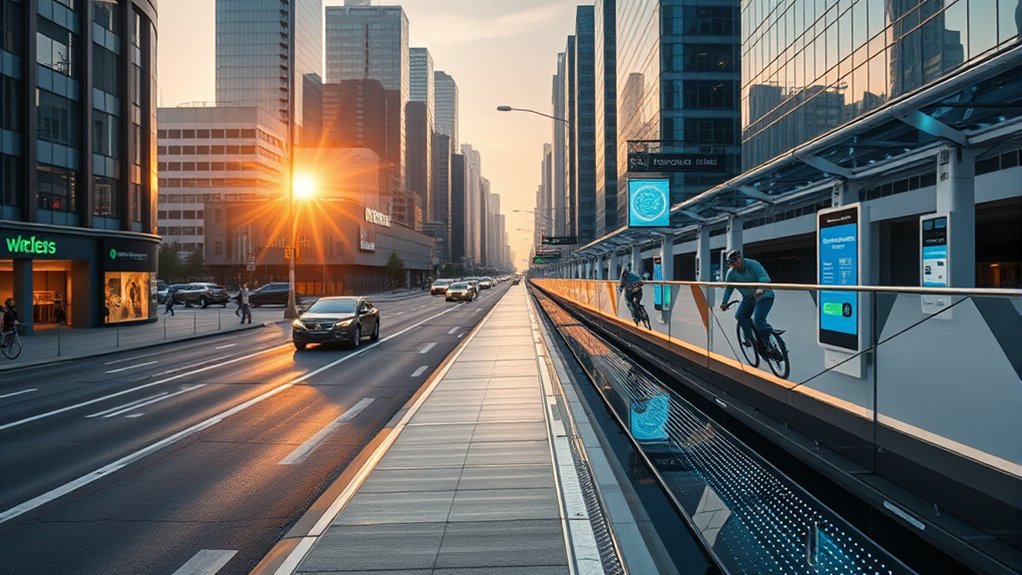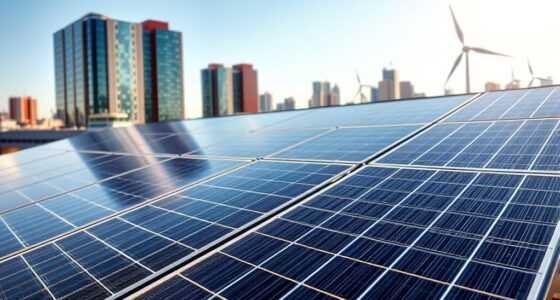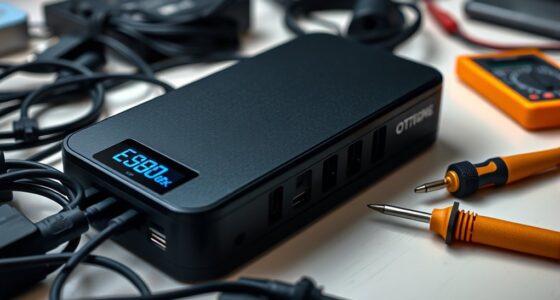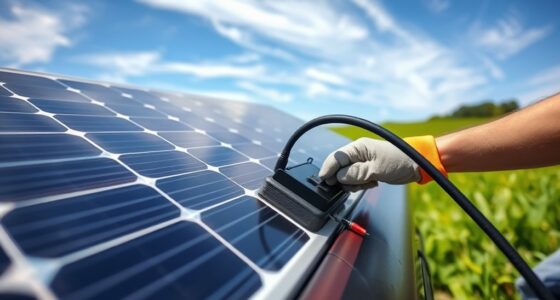Solar roads embed photovoltaic panels into road surfaces that capture sunlight and convert it into electricity, powering streetlights, signals, and nearby buildings. These panels are designed to be skid-resistant, durable, and integrated with sensors to monitor energy use, traffic flow, and maintenance needs. Smart infrastructure enhances safety and efficiency by utilizing connected systems like adaptive traffic signals and sensor-equipped waste bins. Exploring further reveals how these innovative solutions help create more sustainable and resilient urban environments.
Key Takeaways
- Solar roads embed photovoltaic panels that convert sunlight into electricity for urban energy needs.
- Smart infrastructure integrates sensors and controllers within these panels for real-time monitoring and management.
- Data collected from the system optimizes traffic flow, energy use, and maintenance schedules.
- Features like adaptive streetlights and sensor-equipped waste bins enhance urban efficiency and safety.
- Combining solar and smart tech transforms roads into multifunctional energy-generating, resource-efficient city assets.
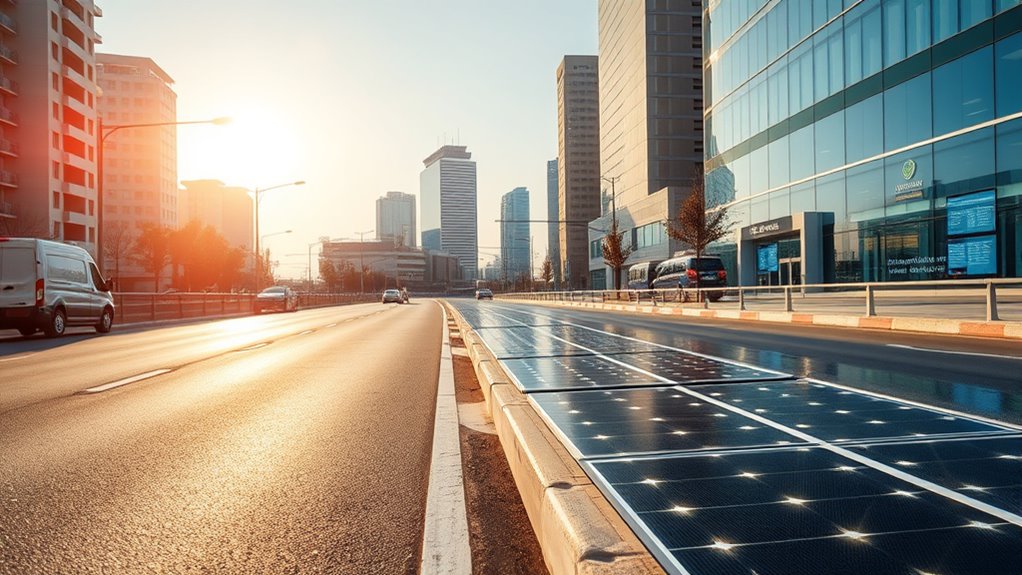
As cities seek sustainable solutions, solar roads and smart infrastructure are emerging as innovative ways to harness renewable energy and improve urban life. These technologies combine the power of solar energy with advanced infrastructure technology to create systems that are both functional and environmentally friendly. Solar roads are fundamentally specially designed road surfaces embedded with photovoltaic panels that capture sunlight and convert it into electricity. This energy can then be used to power streetlights, traffic signals, and even nearby buildings, reducing reliance on traditional power sources. As you walk or drive over these surfaces, you’re directly contributing to a greener energy grid, all without sacrificing pavement quality or safety.
The infrastructure technology behind solar roads involves integrating durable, transparent materials that can withstand harsh weather conditions and heavy traffic. These panels are engineered to be skid-resistant and resilient, ensuring safety for vehicles and pedestrians alike. The panels are linked to a network of sensors and controllers, creating a smart system that monitors energy production, usage, and even traffic flow. This interconnected setup allows for real-time data collection, enabling city planners and engineers to optimize energy consumption and maintenance schedules. You benefit from smarter traffic management, which can ease congestion and enhance safety, all while generating clean solar energy.
Durable, transparent panels powered by sensors create smart, weather-resistant roads that monitor energy and traffic in real-time.
Smart infrastructure extends beyond just solar roads. It includes a variety of interconnected devices and systems designed to improve urban living. For example, smart streetlights automatically dim when no one is around and brighten when they detect movement. Waste collection can be optimized with sensor-equipped bins that signal when they’re full, reducing unnecessary pickups. Traffic signals can adapt dynamically based on real-time traffic data, minimizing delays and emissions. These innovations work together to create a more efficient city environment, where energy is used wisely and resources are managed effectively. As a resident or visitor, you experience smoother transportation, lower energy costs, and a cleaner environment.
In a nutshell, the combination of solar energy and infrastructure technology in smart infrastructure offers a sustainable approach to urban development. It transforms conventional roads and city systems into integrated, energy-producing entities that serve multiple functions. You become part of a city that’s moving toward greater sustainability, where every mile traveled and every streetlight illuminated contributes to a cleaner, smarter future. This approach not only reduces the carbon footprint but also promotes resilience against energy shortages and climate impacts. Utilizing advanced materials in these systems ensures durability and safety for long-term use. By embracing these technological advancements, cities can pave the way for a more sustainable, efficient, and livable environment for everyone.
Frequently Asked Questions
What Are the Maintenance Costs of Solar Roads?
The maintenance costs of solar roads vary based on durability testing and the overall cost analysis. You can expect to spend on repairs due to weather damage, wear and tear, or technology updates. Typically, these costs are higher initially but decrease as the infrastructure proves its durability. Regular inspections help identify issues early, minimizing long-term expenses. Overall, ongoing maintenance is vital to guarantee efficient performance and longevity of solar roads.
How Do Smart Roads Communicate With Vehicles?
You’ll find that smart roads communicate with vehicles through wireless communication, enabling real-time data exchange. About 60% of new vehicles are equipped with Vehicle-to-Infrastructure (V2I) technology, making traffic smoother and safer. As you drive, your car receives signals from the road, such as traffic updates or hazard alerts, via dedicated short-range communication systems. This seamless interaction enhances safety, reduces congestion, and paves the way for autonomous vehicle integration.
Are Solar Roads Effective in All Climates?
Solar roads aren’t effective in all climates because their climate adaptability varies. In extreme cold or heavy snow, snow and ice can block sunlight and reduce energy generation. Additionally, material durability becomes vital in harsh environments, as roads face more wear and tear. If the materials used aren’t resilient enough, the solar roads may degrade faster. So, their efficiency depends on choosing the right materials and designing for specific climate challenges.
What Is the Lifespan of Solar Road Panels?
Solar road panels typically last 20 to 30 years, thanks to their high solar panel durability and sturdy construction. You can expect good road surface longevity if they’re properly maintained, with some panels even exceeding 30 years. Regular inspections and cleaning help preserve their efficiency. Keep in mind that environmental factors, like weather and traffic, can influence their lifespan, but overall, they’re designed to be durable and long-lasting.
How Do Smart Infrastructure Systems Protect User Privacy?
Smart infrastructure systems protect your privacy by using robust data encryption and strict privacy protocols. They guarantee that your personal information remains secure and inaccessible to unauthorized parties. You might notice that data collected for traffic management or maintenance is anonymized, preventing individual identification. These measures help balance the benefits of smart infrastructure with your right to privacy, giving you peace of mind while enjoying advanced, connected systems.
Conclusion
So, next time you see a shiny solar road, don’t just marvel at its brilliance—think of the endless ways it’ll save the planet, or maybe just your morning commute. Smart infrastructure promises a future where roads generate power, traffic manages itself, and we all live happily ever plugged in. Or, you know, it might just be a fancy way to spend tax dollars on a bright idea. Either way, the future’s shining bright—literally.
